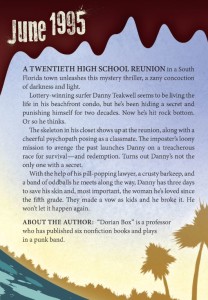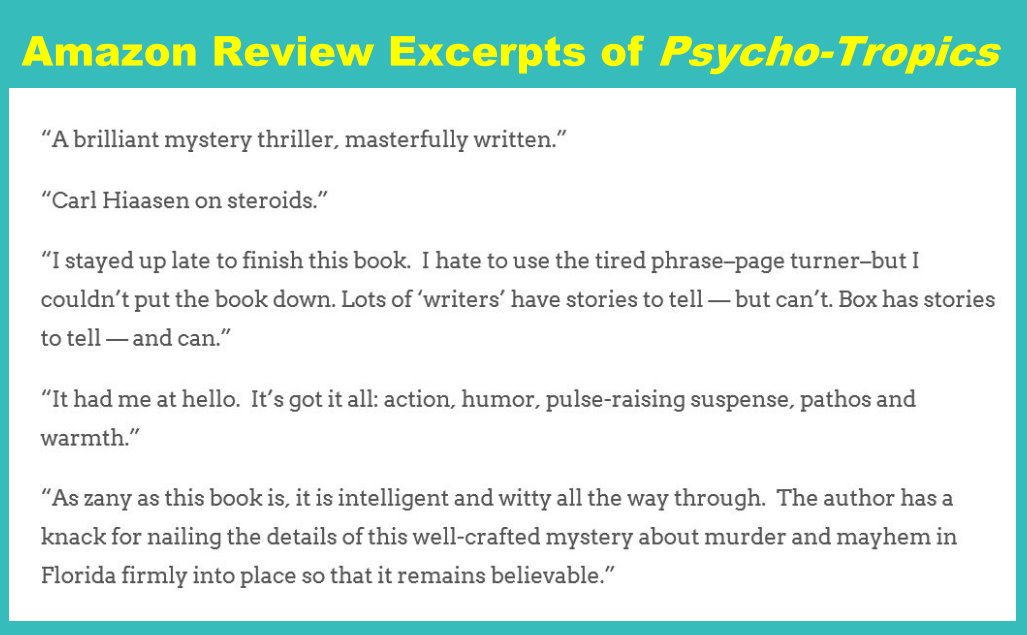The book “blurb.” That elusive quest to capture 100,000 words and years of work in 100-150 words. I’ve written blurbs for my nonfiction books and abstracts for numerous scholarly articles, but composing a blurb for my first novel, Psycho-Tropics, presented unique challenges.
For nonfiction, the blurb generally summarizes the content, not focusing on attention-getting teasers. With fiction, it’s a much finer tightrope. Except for the most well-known writers, the blurb needs to both catch attention and persuade a person who has never heard of you to fork over money for the privilege of reading your book. It has to tantalize while still conveying something concerning what the book is actually about.
(Well-known fiction writers do not face the blurb dilemma. Study the back covers of novels by popular writers and you will rarely spot a blurb, but instead a list of to-die-for reviews.)
Studying blurbs from a bunch of books, I identified three different approaches to writing a novel blurb.
The Pure Teaser Blurb
The pure teaser is a short, intriguing attention-getter. For Psycho-Tropics, it might be something like this:
What if you could go back and bury your biggest mistake? What if it came to bury you first?
This generates a certain intrigue, but would you buy a book from an author with whom you are not familiar based solely on a teaser? I don’t think I would.
The Tweener Teaser/Descriptive Blurb
In composing a blurb Goodreads, I went short and sweet:
A high-school reunion in a South Florida town brings the past to life (literally), launching laidback, lottery-winning surfer Danny Teakwell on a twisted journey of mayhem and mystery through the Sunshine State in search of a missing woman. Pulse-pounding action and whodunit mystery combine with heart and dark humor in this zany tale of revenge, redemption and love, where everyone has a secret and nothing is what it seems.
Definitely more detail concerning the nature of the book than the Pure Teaser, but still no real indication as to what it is about.
The Longer “What It’s About” Blurb
In the end, I went with the blurb below for Psycho-Tropics, based on my thinking that most readers want to have some idea of what a book is about before buying it.
June 1995. A twentieth high school reunion in a South Florida town unleashes this mystery thriller, a zany concoction of darkness and light.
Lottery-winning surfer Danny Teakwell seems to be living the life in his beachfront condo, but he’s been hiding a secret and punishing himself for two decades. Now he’s hit rock bottom. Or so he thinks.
The skeleton in his closet shows up at the reunion, along with a cheerful psychopath posing as a classmate. The imposter’s loony mission to avenge the past launches Danny on a treacherous race for survival—and redemption. Turns out Danny’s not the only one with a secret.
With the help of his pill-popping lawyer, a crusty barkeep, and a band of oddballs he meets along the way, Danny has three days to save his skin and, most important, the woman he’s loved since the fifth grade. They made a vow as kids and he broke it. He won’t let it happen again.
This blurb, which I agonized over for a month, shows that having the luxury of writing the blurb for your own book is both a blessing and a curse. It’s a blessing because no one knows the book as well as you do. I mean, who could possibly appreciate all of the great things about your book except you?
But it’s a curse for the same reason: no one else knows the book as well as you. “How can I possibly summarize this masterpiece in a mere 100 words? It can’t be done.” The result can an overly long blurb containing too many details, which may have happened here. (The blurb clocks in at 160 words.)
What’s your verdict? Not on the specific wording, but what you think is the most effective of the above three approaches: The Pure Teaser Blurb, The Tweener Teaser/Descriptive Blurb, or The Longer “What It’s About” Blurb that gives more details as to what actually happens in the book.



